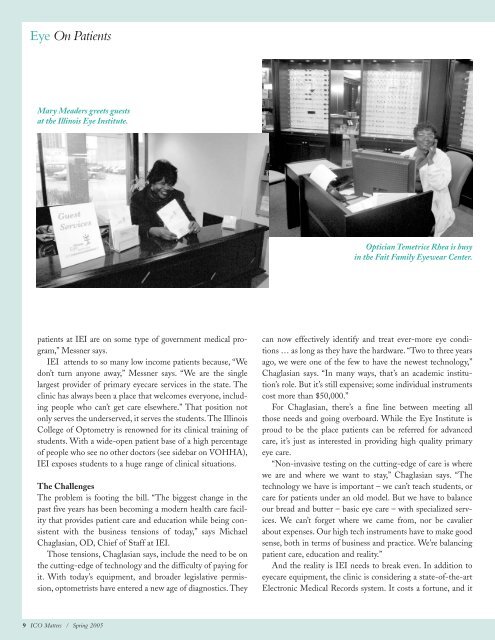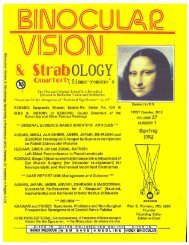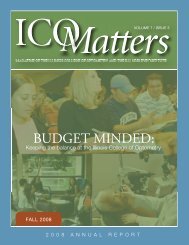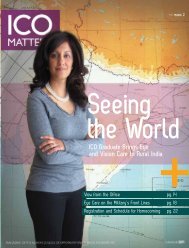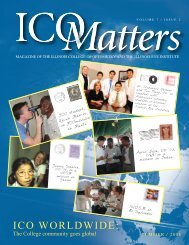EyeOn Patients - Illinois College of Optometry
EyeOn Patients - Illinois College of Optometry
EyeOn Patients - Illinois College of Optometry
Create successful ePaper yourself
Turn your PDF publications into a flip-book with our unique Google optimized e-Paper software.
Eye On <strong>Patients</strong><br />
Mary Meaders greets guests<br />
at the <strong>Illinois</strong> Eye Institute.<br />
patients at IEI are on some type <strong>of</strong> government medical program,”<br />
Messner says.<br />
IEI attends to so many low income patients because, “We<br />
don’t turn anyone away,” Messner says. “We are the single<br />
largest provider <strong>of</strong> primary eyecare services in the state. The<br />
clinic has always been a place that welcomes everyone, including<br />
people who can’t get care elsewhere.” That position not<br />
only serves the underserved, it serves the students. The <strong>Illinois</strong><br />
<strong>College</strong> <strong>of</strong> <strong>Optometry</strong> is renowned for its clinical training <strong>of</strong><br />
students. With a wide-open patient base <strong>of</strong> a high percentage<br />
<strong>of</strong> people who see no other doctors (see sidebar on VOHHA),<br />
IEI exposes students to a huge range <strong>of</strong> clinical situations.<br />
The Challenges<br />
The problem is footing the bill. “The biggest change in the<br />
past five years has been becoming a modern health care facility<br />
that provides patient care and education while being consistent<br />
with the business tensions <strong>of</strong> today,” says Michael<br />
Chaglasian, OD, Chief <strong>of</strong> Staff at IEI.<br />
Those tensions, Chaglasian says, include the need to be on<br />
the cutting-edge <strong>of</strong> technology and the difficulty <strong>of</strong> paying for<br />
it. With today’s equipment, and broader legislative permission,<br />
optometrists have entered a new age <strong>of</strong> diagnostics. They<br />
9 ICO Matters / Spring 2005<br />
Optician Temetrice Rhea is busy<br />
in the Fait Family Eyewear Center.<br />
can now effectively identify and treat ever-more eye conditions<br />
… as long as they have the hardware. “Two to three years<br />
ago, we were one <strong>of</strong> the few to have the newest technology,”<br />
Chaglasian says. “In many ways, that’s an academic institution’s<br />
role. But it’s still expensive; some individual instruments<br />
cost more than $50,000.”<br />
For Chaglasian, there’s a fine line between meeting all<br />
those needs and going overboard. While the Eye Institute is<br />
proud to be the place patients can be referred for advanced<br />
care, it’s just as interested in providing high quality primary<br />
eye care.<br />
“Non-invasive testing on the cutting-edge <strong>of</strong> care is where<br />
we are and where we want to stay,” Chaglasian says. “The<br />
technology we have is important – we can’t teach students, or<br />
care for patients under an old model. But we have to balance<br />
our bread and butter – basic eye care – with specialized services.<br />
We can’t forget where we came from, nor be cavalier<br />
about expenses. Our high tech instruments have to make good<br />
sense, both in terms <strong>of</strong> business and practice. We’re balancing<br />
patient care, education and reality.”<br />
And the reality is IEI needs to break even. In addition to<br />
eyecare equipment, the clinic is considering a state-<strong>of</strong>-the-art<br />
Electronic Medical Records system. It costs a fortune, and it


